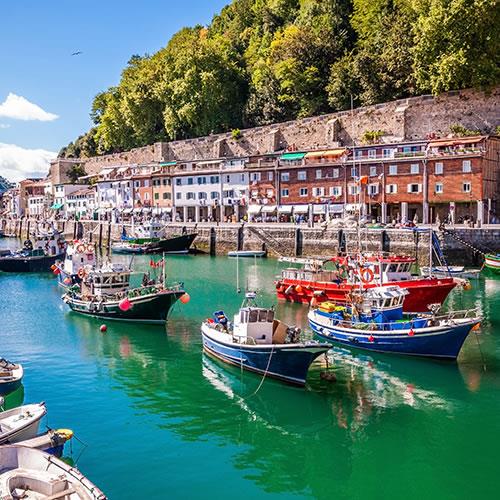


Out of all the regions of Spain, the Basque Country might be the most unique. The culture and traditions in the Basque Country grew separately from the other regions, not only producing popular festivals with strong Pagan roots, but also producing Europe's only language isolate. Vitoria-Gasteiz is the de facto capital, boasting a beautiful Medieval quarter revolving around the Plaza España and the Plaza de la Virgen Blanca. Bilbao is the most industrialized city in the region and one of the country's industry leaders; it benefitted greatly from an urban renewal scheme which led to the opening of the world-class Guggenheim Museum. Donostia/San Sebastián is known for its beautiful architecture, its status as a top foodie destination, and of course the gentle, calming waters of the Bay of Biscay and the beautiful Urumea River.
Asturias, a region in northwest Spain that’s separated from the Castilian Plateau by the Cantabrian Mountains, is a land of contrasts. Once an industrial and mining powerhouse, the area has earned its nickname, Natural Paradise; a third of its territory is now environmentally protected. The jagged coast is beautifully dramatic, sprinkled with lively fishing ports and more than 200 beaches. Inland, the mountain peaks soar high, the valleys are lush, and the villages are delightfully authentic.
The unique Galicia region in Northwestern Spain boasts stunning beaches, small fishing towns, plunging cliffs, wide sweeping bays, rich heritage, and a distinctive culture. The region is home to Santiago de Compostela, the destination of more than quarter of a million visitors that travel each year along the Camino de Santiago trail.
The autonomous region of Cantabria is the epicenter of "Green Spain", the area of Spain known for its lush vegetation due to its position on the Bay of Biscay which brings the area more precipitation than other parts of the country. It is one of the most historic parts of Spain, having been populated for over 40,000 years. This region is also well-known for its beautifully-curated and protected historic old towns, many of which boast buildings dating from the 13th century.
Tens of millions of people visit Spain each year, and many of them combine its picturesque and historic cities, such as the capital, Madrid, with some of the most popular and beautiful beaches in the world. Whether you`re going to sun yourself on the Mediterranean Costas, the Bay of Biscay shoreline, or off the mainland and on one of Spain`s gorgeous islands, you will find a Spanish city and beach holiday best suited to your needs and wants.
Spanish cuisine is very flavorful, and is a quintessential Mediterranean diet, befitting the world`s largest olive oil producer and second-largest wine producer. Spain`s former colonies all over the world influenced the cuisine at home, in everything from tomato sauce to saffron. Today, the various regional staple delicacies represent history and tradition.
Spain has the third most UNESCO World Heritage Sites of any country in the world. From Iberian Peninsula’s most antique villages and old towns to cobblestoned Romanesque streets and breathtaking architecture, there are 48 impressive UNESCO sites to visit in Spain. Countless cultures have passed through this country leaving their incredible influences and making Spain a cultural paradise.
With one of the most extensive systems of roads and highways in the world, clocking in at over 10,000 miles, Spain is very easy to traverse by car. Major highways connect all of Spain`s 45 mainland provinces with one another, and they can be found in the Balearic and Canary Islands as well.
The Spanish Empire was one of the most powerful and enduring, lasting from 1492 until 1976. By the year 1516, the Kingdoms of Castile, Aragon, Granada, and others were united under the Spanish crown. This is in addition to other storied kingdoms which existed pre-1516 in Spain`s current borders, such as Galicia, Leon, and the Moorish Almohad Caliphate. The cities in the regions that once comprised the Kingdoms of Spain are filled with thousands of years of history and monuments that predate the singular Spanish crown.
The historic cities near Madrid, Spain`s vibrant capital, offer some of the world’s most historic and unique sights. Many of Spain`s oldest universities, cathedrals, monasteries, and historic monuments are located here. Medieval architecture, Roman monuments, palaces, and unique hanging houses are just a train or a car ride away from Madrid, in such cities as León, Burgos, Valladolid, Salamanca, and Avila in Castile and León; Toledo and Cuenca in Castilla-La Mancha; and Caceres and Merida in Extremadura.